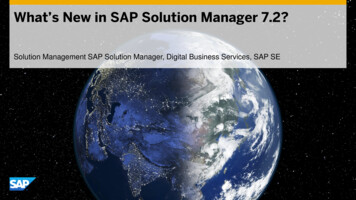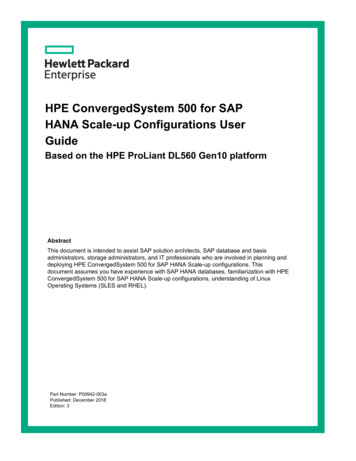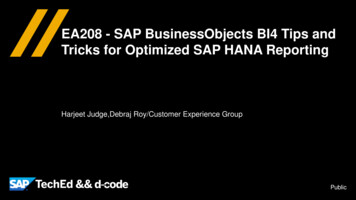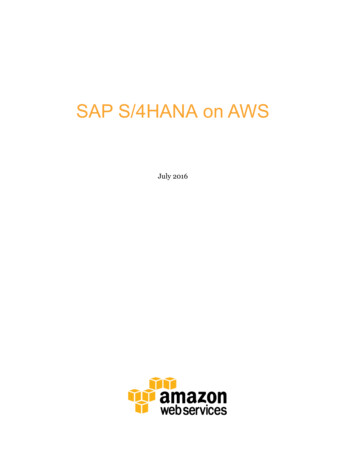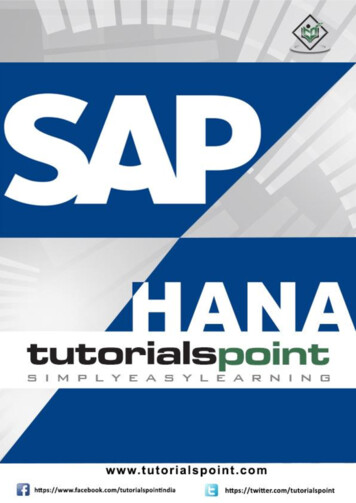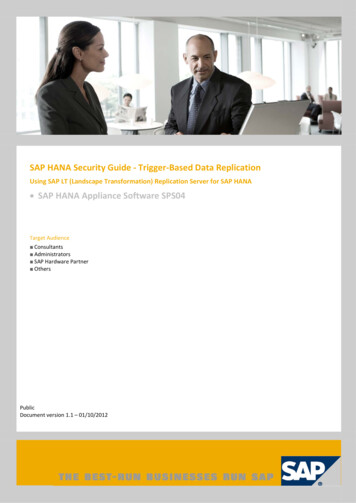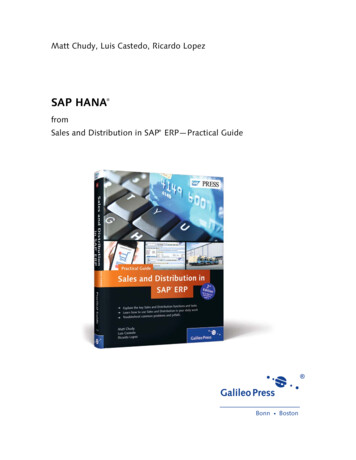
Transcription
Matt Chudy, Luis Castedo, Ricardo LopezSAP HANA fromSales and Distribution in SAP ERP—Practical Guide Bonn 폷 Boston
Explore SAP HANA as a new technology in SAP, and learn how SAPHANA provides additional functionality to Sales and Distribution foranalytics.SAP HANASAP HANA is the technology that allows you to perform massive analyses of realtime data in-memory. The in-memory database was created as a response to thebusiness need to immediately access real data in real time. Retrieving informationis a challenge, especially when a massive amount of data is handled. In-memorydata reads around 15 times faster than a traditional database stored in the harddrive. Therefore, in-memory databases can read records in about 5 nanoseconds,as opposed to traditional databases, which read disk records in 5 milliseconds.Your applications, analytics, and programs will run faster in an in-memory environment such as SAP HANA. Using SAP HANA, your company will be able tounlock new customer insights rapidly, because it provides you with data miningand predictive analytics and storage solutions, in addition to real-time operation.SAP HANA is projected to be the platform for future SAP development, includinganalytics and applications. It currently provides you with an enhanced solutionfor data storing and analytics. Therefore, it’s important for you to understand thebasic concepts as well as the overall technology.This chapter will further investigate SAP HANA, and look more deeply into SAPHANA analytics related to the Sales and Distribution component, specifically inSAP HANA-Optimized BI content. You’ll learn about SAP HANA-Optimized BIcontent for SD to obtain customers’ sales orders, deliveries, and billing analytics.You’ll also learn about SAP Fiori data sources from orders to invoices, and queriesthat are commonly used.Let’s get started by taking a look at SAP HANA’s internal components. Galileo Press, Boston 20153
SAP HANASAP HANA ComponentsThe in-memory database combines a row-based, column-based, and object-baseddatabase technology. This combination gives a unique view of how SAP exploresthe parallel processing capabilities of the latest CPU architecture using RAMmemory. The traditional database data replicates on average once a day or weeklyor monthly, commonly known as the “refresh” cycle; therefore a traditional DBwon’t contain “fresh” data. This traditional method uses OLTP (Online Transaction Processing), where a traditional database’s memory is distributed at the hardware level and hard disk to serve the applications on daily activities.In contrast, in an SAP HANA in-memory database, the transactions are updated tothe in-memory (RAM memory) in a matter of milliseconds. Figure 1 shows you asimplified comparison between the traditional versus the in-memory databasearchitecture. The in-memory solution will give you the benefit of better hardwareusage for each application, and faster analytics in real time for all SAP ERP components, including Sales and Distribution analytics. It resides in the SAP HANAappliance (DB), and the entire cache of data is stored in RAM.TraditionalSAP HANABusinessObjectsApplicationSAP ERPOtherBusinessSuitesOLTPOLTPOtherObjectsSAP HANAappliance BDin-memoryOLTPOtherSourcesSAP BWFigure 1 Example of traditional DB and SAP HANA BDYou now understand what SAP HANA does, but you should also know what SAPHANA is, in a technical respect. SAP HANA is not a single component, but rathera collection of software and hardware under the SAP HANA rubric. The maincomponents are depicted in Figure 2 and explained in more detail in the following list.4 Galileo Press, Boston 2015
SAP HANA as a PlatformSAP HANASAP HANAdatabaseSAP HANAStudioSAP HANAAppliancesSAP HANAApplication CloudFigure 2 SAP HANA Main Components왘SAP HANA databaseRelates to the main database itself, and the in-memory database called SAPHANA DB.왘SAP HANA StudioRefers to the modeling tools provided by SAP to model the data for SAP HANADB.왘SAP HANA ApplianceRefers to the combination of hardware and software specially adapted to thehardware. Several vendors offer this hardware/software combination as appliances. SAP HANA Appliances refers to the SAP HANA DB, Studio, and othertools as appliances.왘SAP HANA Application CloudSAP HANA is also available as a service under the cloud. Delivery of an appliance could also be granted via the cloud.The combination of the above key components gives us what’s known as SAPHANA. Let’s now address how SAP HANA is more than a database, and how itbecomes a platform.SAP HANA as a PlatformSAP HANA is more than an enhanced database, as you may have realized by now.SAP HANA established a platform for today and SAP developments to comebecause it’s a combination of software and hardware. SAP HANA will provideyour company with both solutions—data storage and data analytics—in oneplace, providing you with fast results that translate into real-time answers to yourcustomers’ demands. Galileo Press, Boston 20155
SAP HANASAP HANA combines database and application platform capabilities under an inmemory operation. This technology lets you transform transactions, analytics,text analysis, and predictive processing, allowing your company to operate in realtime. Figure 3 shows the three main levels of SAP HANA as well as how any datacan be processed (structured data, social network, text or machine data, or RFID)via the SAP HANA platform to leverage every unique opportunity, from regularuser terminals to mobile devices such as tablets and smartphones.LaptopSmartphonesTabletsSAP HANA PlatformDatabase andadvanced dataprocessing servicesStructuredand unstructureddataApplication platformservicesSocial networksIntegration and datavisualization servicesRFIDMachine dataMission-criticaldeployment services(on premise, cloud,or hybrid)TransactionalOther appsFigure 3 SAP HANA PlatformUsing the SAP HANA platform, your company can run all transactional and analytical applications on the same data at the same time in real time. Because it’s inmemory, it’s designed to handle massive amounts of data at unprecedentedspeeds; furthermore, SAP HANA can be deployed on premise or in the cloud, simplifying your IT department and reducing the complexity of your architecture.Here are the key characteristics of the SAP HANA platform:왘Solutions based on in-memory computing왘Platform combining hardware and software6 Galileo Press, Boston 2015
SAP HANA Migration Options왘Real-time data analytics and predictive, including data created as it happens왘Ability to manages large volume as well as detailed data왘Flexibility and scalability왘Real-time applicationsYou now better understand what’s important about SAP HANA and how you maybenefit from it. However, a new question may arise: what does it take to convertto SAP HANA’s in-memory environment? Let’s take a look at the overall choicesSAP provides to their customers for SAP HANA database migration.SAP HANA Migration OptionsSince its creation, a number of companies have already successfully migrated toSAP HANA. In fact, based on its experience, SAP has created three main migrationstrategies to meet the needs of a diverse range of clients and ensure successfulmigrations. The three main migration strategies are depicted in Figure 4. Eachoffers specific advantages. All of them have been thoroughly road tested by SAP.Option 1Option 2Option 3New InstallationClassical migrationOne-step upgrade andmigration with DMONew system inSAP HANAStep 1: UpdateSAP system withSAP HANADecide whether ornot to change theexisting solutionStep 2: Migratetraditionaldatabase toSAP HANA DBUse DatabaseMigration Option(DMO), whichcombines upgradeand databasemigration in onestep, one tool,and onedowntimeFigure 4 SAP HANA Migration OptionsLet’s look at the different options:왘Option 1: new installationThis option represents a change to the existing landscape and solution. It’scommonly used when starting over in a new environment or to take designcorrection actions. Galileo Press, Boston 20157
SAP HANA왘Option 2: classical migrationThis option is based on two steps: the initial update to the SAP system (SAPHANA), and then the migration of the traditional database into SAP HANA DB.This strategy is mostly used when you need your new environment to looksimilar to your old one.왘Option 3: one-step upgrade with DMOThis will give you the upgrade and migration in one step, as a “big bang”approach. These are frequently perceived as the most risky option. However,they also represent the minimum downtime required out of the three options.Now we’d like to address how SAP HANA impacts Sales and Distribution, via SAPBW and analytics. Today, SD is enhanced with this new SAP HANA technology,so let’s explore the details in the following section.SAP HANA-Optimized BI Content in Sales and DistributionIn Chapter 1, we introduced some of the concepts in BI/BW, which are applicablefor SD, as well as commonly used terminology. Until recently, SD enhancementshave been based primarily in the BI area with the use of active DataStore objects(DSOs); we’ll discuss the features that are available now, but keep in mind thatSAP HANA for SD is expected to continue to grow and to provide further functionality in the near future.We also introduced SAP HANA-Optimized BI content for Sales and Distributionin Chapter 1, which we’ll examine in more detail in the following sections.Sales and Distribution SAP HANA-Optimized DatStore Objects (DSO)DSO is the technology that SAP HANA created in an effort to reduce storageamount and accelerate data loads, using in-memory optimized data structures.The data model follows the LSA requirements, for the use of SAP BW onHANA.SAP HANA-Optimized BI content is available for Sales and Distribution in the following areas:왘Sales orders왘Delivery data왘Billing data8 Galileo Press, Boston 2015
SAP HANA-Optimized BI Content in Sales and Distribution왘Condition data왘Delivery service dataLSA The Layered Scalable Architecture (LSA) is the reference architecture for building anEnterprise Data Warehouse with SAP BW. LSA is optimized for BW running on SAPHANA.You can find a list of the most commonly used DataSources in Sales and Distribution in Table 1. The data flow starts from the extraction of the Sales and Distribution table into the DataSources, which in turns flows to the Infosources, DSO, andMultiproviders as described.SD DataSources DescriptionInfosourceDSOMultiprovider2LIS 11 VAHDR Sales DocumentHeader Data/IMO/SD IS10 /IMO/SD D10 (/IMO/SD M10)2LIS 11 VAITMSales Document Item Data/IMO/SD IS11 /IMO/SD D11 (/IMO/SD M10)2LIS 11 V ITMSales-Shipping AllocationItem Data/IMO/SD IS16 /IMO/SD D16 (/IMO/SD M10)2LIS 12 VCHDR Delivery Header Data/IMO/SD IS20 /IMO/SD D20 (/IMO/SD M10),(/IMO/SD M20)2LIS 12 VCITM/IMO/SD IS21 /IMO/SD D21 (/IMO/SD M10),(/IMO/SD M20)Delivery Item Data2LIS 13 VDHDR Billing DocumentHeader Data/IMO/SD IS30 /IMO/SD D30 (/IMO/SD M10),(/IMO/SD M30)2LIS 13 VDITM/IMO/SD IS31 /IMO/SD D31 (/IMO/SD M10),(/IMO/SD M30)Billing DocumentItem Data2LIS 11 VACON Order Condition Data/IMO/SD IS14 /IMO/SD D14 (/IMO/SD M40)2LIS 13 VDKON Billing Condition Data/IMO/SD IS34 /IMO/SD D34 (/IMO/SD M40)HANA Information ModelBackorders overview/IMO/SD D50 (/IMO/SD V01) –Virtual Provider(/IMO/SD M51)Table 1 Data Flow in Key DSOs for Sales and Distribution Galileo Press, Boston 20159
SAP HANANoteIf you are in SAP BW 7.30 on SAP HANA with SP8 or higher, conversions from standardDSOs to SAP HANA-optimized DSOs are no longer required. If you have a previous version, conversion will still be required.SD Rebates Processing: Optimized with SAP HANAIn Chapter 5, specifically Section 5.5, we addressed the most typical rebate processing procedure in Sales and Distribution, including standard and retroactiveagreements. A rebate is a special discount granted to a customer retroactively.The calculated rebate amount depends in its entirety on the invoiced salesarchived by your customer during a given period of time. Rebates are defined viathe condition records.Due to their retroactive accumulation, rebates normally face large data volumes,especially when those rebates cross fiscal years or even, for consumer goods,when many customers (possibly millions of them) are accumulating rebate discounts under one or several condition records. The problem is very common.Under the traditional rebate approach in SD, at the end of the period, rebatecredit memos are issued. A table index was introduced to handle the high processing times and volumes that occur at the end of the rebate period. This indexprovides links to all rebate-relevant invoices (SAP Table VBOX).You’ve probably faced problems with this rebate index table (VBOX) before, especially if you’re part of a large company. It’s very common to find that VBOXgrows significantly over the course of the rebate period. VBOX can reach billionsof database records under scenarios with 1,000 or more rebate customers. A largeVBOX with billions of records could represent 20% or more of the entire databasespace, which could also slow down the database performance.What are your options when this happens? The most common solution is to splitVBOX for the customer rebates, and to rebuild the index table. Both activities arerisky and costly for your company. SAP HANA is an alternative solution—youmay be surprised to hear that some SAP customers are now actually dropping theSAP VBOX table. With SAP HANA, the primary documents or invoices can beaccessed without the need for indexes, primarily due to the speed of SAP HANAdata recovery and display. Under SAP HANA, rebate conditions are easy to access10 Galileo Press, Boston 2015
SAP Fiori for SDand update. You can change rebate conditions to current rebate customers, ormake new customers rebate-eligible. Not using the VBOX index also has otheradvantages: your database size will be reduced, allowing savings in data redundancy.Overall, rebate processing is streamlined with SAP HANA by encouraging fewerprocess steps and avoiding updates to the index, in addition to the flexibility provided by the easy access to the customer’s rebate information. Once you havemigrated into an SAP HANA environment, we recommend that you try this solution for rebates. This is just one example of how SAP HANA is improving currentsolutions.Another application under SAP HANA is SAP Fiori. We briefly discussed this inChapter 1, but now let’s discover how Fiori will enhance the Sales and Distribution functionality.SAP Fiori for SDSAP Fiori is a collection of applications created by SAP under the new SAP userexperience (UX) paradigm. SAP Fiori is part of the HANA suite of productslaunched in 2013. Since then, more than 300 applications (apps) have beenlaunched in Waves 1 to 5 as of July 2014, and more SAP Fiori app waves are forecasted in the next couple of years.SAP Fiori supports the most common line of business by providing applicationsin Finance, HR, Manufacturing, and Sales and Distribution.SAP Fiori 1:1:1:3:N ConceptSAP Fiori applications are designed on the 1:1:1:3:N concept, as a way to simplifyyour SAP screens and improve the user experience. Figure 1.5 shows the constantevolution from the current SAP GUI into simpler and more user-friendly UXscreens on mobile devices and workstations. You can understand the concept ofUX 1:1:1:3:N as it refers to 1 (User), 1 (Scenario), 1 (Code), 3 (Screens), and N(Platforms). This is how you will benefit from significantly better screens, simplified flows, and renewed transactions with the use of SAP Fiori apps. Galileo Press, Boston 201511
SAP HANASAP GUI TraditionalSAP FioriFigure 5 SAP FIORI UX EvolvingSAP Fiori UX, App TypesTo provide you with the best user experience, SAP Fiori provides four types ofapps. Let’s discuss the differences between them:왘TransactionalTask-based apps, where tasks such as change, create or approve are performed.You can run transactional apps using your current database. For transactionalapps, SAP HANA migration is not mandatory.왘AnalyticalApps dedicated to trigger insights and KPIs, or other related analyses.왘FactsheetApps that allows you to search and explore information.왘SAP Smart BusinessApps that allow you to analyze and evaluate strategic or operation KPIs in realtime.12 Galileo Press, Boston 2015
SAP Fiori for SDNoteSince transactional apps don’t require SAP HANA migration, you’ll be able to experiment with SAP Fiori on your current database using transactional apps almost immediately.SAP Fiori SD AppsOut of the 300 apps that have been released in Q2 2014, Table 2 shows the mostcommonly used SAP Fiori apps that are specifically designed for SD. We recommend that you verify the listed apps, and determine which ones are most suitableto your specific needs and business. You should also check to see whether anyfurther waves of apps have been released. As a reminder, transactional apps canbe implemented with your current database, which means that installation of theSAP HANA environment is optional for this type of app. (That’s right: you canbenefit from SAP Fiori transactional apps without even installing SAP HANA!)SAP FIORI AppApp TypesCreate Sales OrdersTransactional appCustomer InvoicesTransactional appMy ContactsTransactional appMy Leave RequestsTransactional appTrack Sales OrdersTransactional appTrack ShipmentsTransactional appCustomerFact sheetCustomer Billing DocumentFact sheetGoods IssueFact sheetMaterialFact sheetSales ContractFact sheetSales Group ContractFact sheetSales OrderFact sheetTable 2 Commonly Used SAP Fiori Apps for SD Galileo Press, Boston 201513
SAP HANASAP FIORI AppApp TypesSales QuotationFact sheetDelayed Deliveries (in Transit)Analytical appDelayed Deliveries (POD)Analytical appDelayed Deliveries (Total)Analytical appMy Quotation PipelineAnalytical appSales PerformanceAnalytical appSAP Smart Business for Sales Order FulfillmentAnalytical appTransportation CostAnalytical appUncovered Sales OrdersAnalytical appTable 2 Commonly Used SAP Fiori Apps for SD (Cont.)14 Galileo Press, Boston 2015
HANA. Let's now address how SAP HANA is more than a database, and how it becomes a platform. SAP HANA as a Platform SAP HANA is more than an enhanced data base, as you may have realized by now. SAP HANA established a platform for today and SAP developments to come because it's a combination of software and hardware. SAP HANA will provide


